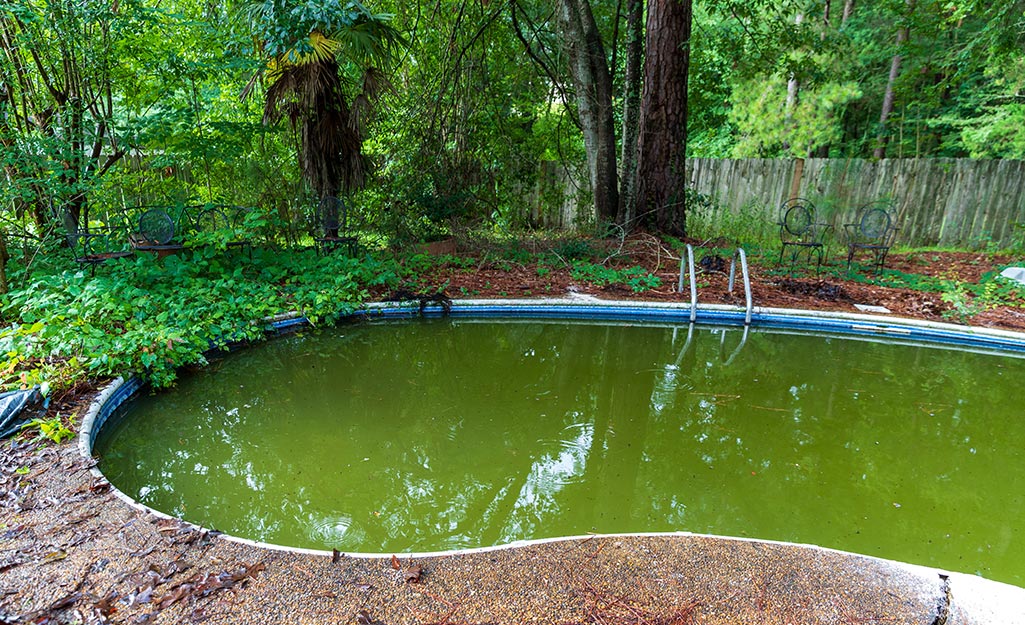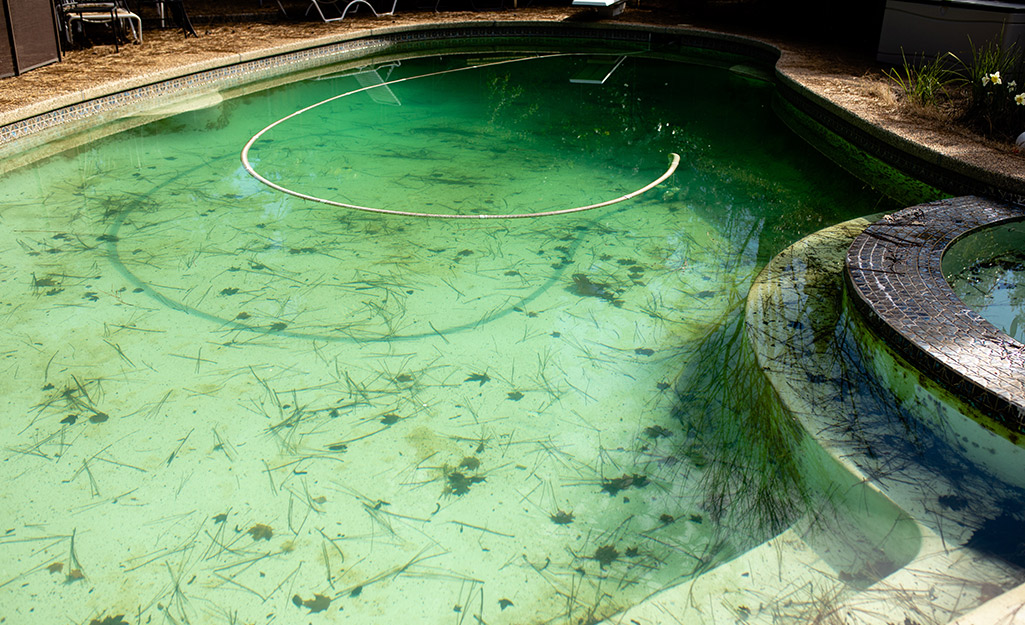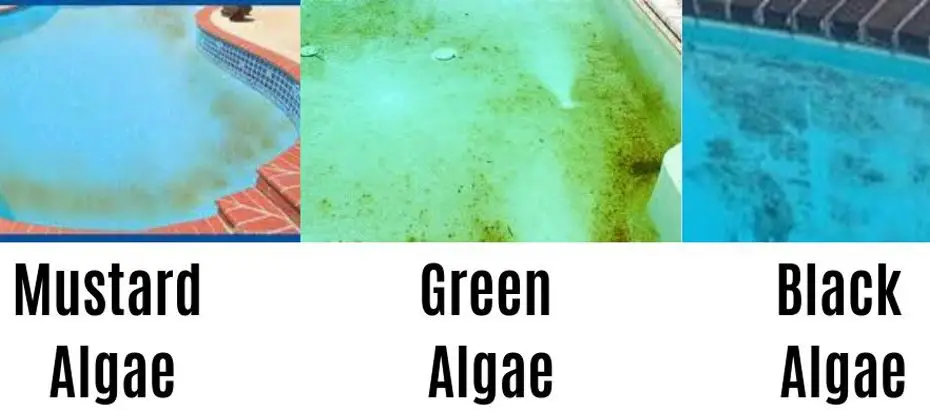To get algae out of a pool, you need to shock the pool with a strong chlorine solution and scrub the affected areas with a pool brush. If you have noticed green, slimy patches forming on the walls or floor of your pool, chances are that you have an algae problem.
Algae is a common nuisance in swimming pools, especially when there is insufficient sanitizer or improper maintenance. This unsightly growth not only makes the pool look unappealing but can also pose health risks to swimmers. However, by following a simple process, you can effectively get rid of algae and restore the pristine condition of your pool.
In this guide, we will walk you through the step-by-step process of eliminating algae infestations and ensuring a clean and healthy swimming environment.

Credit: www.homedepot.com
Identifying Algae
Recognizing Algae Growth
When you notice a green tint or slippery patches on the pool walls and floor, it is likely algae growth. Algae thrive in warm, sunlit water with poor circulation and sanitizer levels. Regular monitoring of your pool’s condition and water can help detect algae growth in its early stages.
Different Types Of Algae
There are three main types of algae that can affect your pool – green, yellow/mustard, and black algae. Green algae is the most common and can quickly spread and turn the water cloudy. Yellow/mustard algae often clings to pool walls and can be more resistant to regular sanitization methods. Black algae forms roots that embed themselves in pool surfaces, making it challenging to eradicate.

Credit: www.homedepot.com
Prevention Measures
Preventing algae from thriving in your pool is essential for maintaining clean and clear water. By implementing the following prevention measures, you can keep algae at bay and ensure your pool remains a refreshing oasis all season long.
Regular Water Testing
Regularly testing the water in your pool is crucial to maintaining a proper chemical balance and preventing the growth of algae. Utilize a test kit to monitor the pH, chlorine levels, alkalinity, and other essential parameters. By regularly checking these factors, you can promptly identify and address any imbalances that could promote algae growth.
Proper Chlorination
Proper chlorination is key to preventing algae from taking hold in your pool. Ensure that the chlorine levels are maintained at the appropriate range, typically between 1.0-3.0 parts per million (ppm). In addition, it’s important to shock the pool regularly to eradicate any lingering algae spores. Regularly maintaining the chlorine levels and performing shock treatments when needed will help to effectively prevent algae outbreaks.
Manual Removal Methods
Effective manual removal methods are crucial for getting rid of algae in a pool. Some popular techniques for manual removal include brushing and scrubbing, as well as vacuuming.
Brushing And Scrubbing
- Use a pool brush to scrub the walls and floor thoroughly.
- Focus on areas with visible algae growth.
- Brush in overlapping strokes to dislodge algae from surfaces.
Vacuuming
- Attach a pool vacuum to the filtration system.
- Move the vacuum methodically over the pool surface.
- Empty the vacuum’s collection bag regularly.

Credit: www.pinterest.com
Chemical Treatments
If you have noticed algae growth in your pool, chemical treatments can effectively get rid of them. Algae growth not only ruins the aesthetic appeal of your pool but can also pose health risks for swimmers. In this section, we will discuss the different chemical treatments you can use to eliminate algae from your pool.
Algaecides Overview
Algaecides are chemical compounds specifically designed to combat algae growth in pools. They work by destroying and preventing the growth of algae spores, ensuring your pool remains clean and free from any green or black patches.
There are two types of algaecides available:
- Copper-based Algaecides
- Quaternary Ammonium (Polyquat) Algaecides
Copper-based Algaecides: These algaecides contain copper sulfate or copper chelates as their active ingredients. Copper ions are highly effective at eliminating algae and can prevent future growth. However, prolonged use of copper-based algaecides can lead to staining on pool surfaces, especially if your pool’s pH level is not properly balanced.
Quaternary Ammonium (Polyquat) Algaecides: These algaecides are non-staining and safer to use compared to copper-based alternatives. They work by breaking down the cellular structure of algae, preventing their growth. Polyquat algaecides are particularly useful for preventing the recurrence of algae blooms.
Shock Treatment
Shock treatment is another effective chemical treatment for eliminating algae from your pool. This process involves adding a large dose of chlorine to the pool water, effectively raising the chlorine levels to kill off the algae. Shock treatments work well for persistent algae growth, and they also help in maintaining chlorine levels in your pool.
Here’s a step-by-step guide to performing a shock treatment:
- Test the water: Use a pool testing kit to determine the current chlorine and pH levels of your pool water.
- Balance the water chemistry: Adjust the pH and alkalinity levels as necessary to ensure optimal conditions for the shock treatment.
- Add shock treatment chemicals: Follow the instructions provided with the shock treatment product and add the recommended amount to your pool water. Ensure the product is evenly distributed throughout the pool.
- Run the pool pump and filter: Keep the pool pump and filter running continuously for at least 24 hours to circulate and filter the water effectively.
- Retest the water: After 24 hours, test the water again using a pool testing kit. Ensure the chlorine levels are within the recommended range.
Remember to follow the manufacturer’s instructions when using shock treatment chemicals, and always wear appropriate protective gear to avoid any contact with the chemicals.
Filtration System Maintenance
Proper maintenance of the filtration system in your pool is crucial for keeping algae at bay. Regular cleaning and ensuring proper circulation are key to efficient filtration system maintenance.
Cleaning Filters Regularly
Cleaning pool filters regularly ensures optimal filtration efficiency. Gently rinse cartridges or backwash sand filters frequently.
Ensuring Proper Circulation
Maintaining proper circulation prevents algae growth. Verify that the pump and skimmer are working correctly.
Sunlight And Algae Growth
Understanding the relationship between sunlight and algae growth is crucial when it comes to maintaining a pristine pool. Algae is a common nuisance that can quickly take over your pool if not properly managed. Sunlight is one of the primary factors that contribute to the growth of algae in pools. In this section, we’ll delve deeper into how algae and sunlight interact, and explore effective ways to prevent excessive sunlight exposure to keep your pool clear and refreshing.
Understanding Algae’s Relationship With Sunlight
Algae is a plant-like organism that thrives in moist environments, and your pool provides the perfect breeding ground. It uses sunlight as an energy source for photosynthesis, a process that allows algae to produce food and grow. Sunlight provides the necessary fuel for algae colonies to multiply and spread, leading to unsightly green or yellow discoloration in your pool water.
However, it’s important to note that not all types of algae require sunlight to grow. Some strains, such as black algae, can survive in shaded areas. Nevertheless, sunlight plays a significant role in promoting the growth and proliferation of most types of algae.
Preventing Sunlight Exposure
To prevent excessive sunlight exposure and inhibit algae growth, it’s essential to implement appropriate preventive measures. Here are some effective strategies:
- Invest in a Pool Cover: A pool cover is an invaluable tool in blocking sunlight and preventing the growth of algae. When your pool is not in use, covering it with a durable and UV-resistant pool cover creates a physical barrier that limits sunlight penetration.
- Utilize Pool Shade Structures: Installing shade structures, such as umbrellas or pergolas, near your pool can provide additional protection against direct sunlight. These structures create shaded areas that reduce sunlight exposure, making it harder for algae to thrive.
- Regularly Trim Surrounding Trees and Plants: Overhanging trees and plants can cast shadows over your pool, creating areas where sunlight has limited access. Regularly trimming foliage around your pool will ensure there are no shaded spots for algae to flourish.
- Manage Pool Water Circulation: Proper water circulation is key to preventing algae growth. Ensure that your pool’s filtration system is operating optimally, and regularly clean and maintain it to keep algae at bay.
- Monitor and Balance Pool Chemicals: Maintaining proper chemical balance is vital for maintaining a healthy pool environment. Regularly test and adjust the pH and chlorine levels in your pool to create conditions that are unfavorable for algae growth.
By understanding the link between sunlight and algae growth and taking proactive steps to prevent excessive sunlight exposure, you can effectively tackle algae problems and keep your pool crystal clear all summer long.
Professional Help
Professional help can be crucial when attempting to remove stubborn algae from your pool. Knowing when to call a pool expert and understanding the benefits of hiring a professional can save you time, effort, and potential frustration in the long run.
When To Call A Pool Expert
If your attempts to clear the algae in your pool have been unsuccessful after several treatments and the water quality continues to deteriorate, it may be time to seek assistance from a pool expert. Additionally, if you notice any abnormal changes in the pool equipment, such as the filter, pump, or water circulation, it’s best to consult with a professional to prevent further damage.
Benefits Of Hiring A Professional
- Expertise: Pool professionals have the knowledge and experience to accurately diagnose the type of algae infestation and apply the appropriate treatment.
- Efficiency: By hiring a professional, you can save time and energy, as they have the tools and resources readily available to address the algae problem promptly.
- Preventative Maintenance: Pool experts can also provide valuable advice on preventive measures to avoid future algae growth, ultimately maintaining the clarity and hygiene of your pool water.
Final Tips And Tricks
Maintaining Proper pH LevelsProper pH levels are crucial to preventing algae growth in your pool. Regularly test the water using a pool testing kit and adjust the pH as needed to keep it between 7.4 and 7.6.
Regular Pool Maintenance ScheduleEstablishing a regular maintenance schedule is vital to keeping algae at bay. Create a routine for skimming the surface, vacuuming, and brushing the pool walls to prevent debris buildup that can nourish algae growth.
Conclusion
Keeping your pool algae-free is essential for a safe and enjoyable swimming experience. By following these simple steps, you can effectively remove algae from your pool, ensuring crystal-clear water for you and your loved ones to enjoy. Stay proactive and maintain a clean pool year-round.
Happy swimming!





